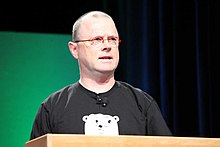Rob Pike
Rob Pike | |
|---|---|
 | |
| Born | 1956 (age 67–68) |
| Nationality | Canadian |
| Occupation | Software engineer |
| Employer | |
| Known for | Plan 9, UTF-8, Go |
| Spouse | Renée French |
| Website | herpolhode |
Robert Pike (born 1956) is a Canadian Programmer and author. He is best known for his work at Bell Labs, where he was a member of the Unix team and was involved in the creation of the Plan 9 from Bell Labs and Inferno operating systems, as well as the Limbo programming language.
He also co-developed the Blit graphical terminal for Unix; before that he wrote the first window system for Unix in 1981. Pike is the sole inventor named in AT&T's US patent 4,555,775 or "backing store patent" that is part of the X graphic system protocol and one of the first software patents.[1]
Over the years Pike has written many text editors; sam[2] and acme are the most well known and are still in active use and development.
Pike, with Brian Kernighan, is the co-author of The Practice of Programming and The Unix Programming Environment. With Ken Thompson he is the co-creator of UTF-8. Pike also developed lesser systems such as the vismon program for displaying images of faces of email authors.
Pike also appeared once on Late Night with David Letterman, as a technical assistant to the comedy duo Penn and Teller.[verification needed]
Pike is married to Renée French, and currently works for Google, where he is involved in the creation of the programming languages Go and Sawzall.[3]
See also
- The Plan 9 from Bell Labs operating system.
- Acme: A User Interface for Programmers
- The Plumber
- The Sam text editor
- Mark V Shaney
- The Unix Programming Environment (1984 with Brian Kernighan)
- Go (programming language)
- Sawzall
References
- ^ Rob (2006-06-11). "Command Center". Commandcenter.blogspot.com. Retrieved 2013-06-25.
- ^ McIlroy, M. D. (1987). A Research Unix reader: annotated excerpts from the Programmer's Manual, 1971–1986 (PDF) (Technical report). CSTR. Bell Labs. 139.
- ^ Pike, Rob; Dorward, Sean; Griesemer, Robert; Quinlan, Sean (2005-01-01). "Interpreting the Data: Parallel Analysis with Sawzall". Scientific Programming. 13 (4): 227–298.
External links
- The Good, the Bad, and the Ugly: The Unix Legacy – Slides of his presentation at the commemoration of 1000000000 seconds of the Unix clock.
- Systems Software Research is Irrelevant (a.k.a. utah2000) slides
- Pike's personal homepage
- Pike's Google homepage
- Questions and Answers with Rob Pike by Robin "Roblimo" Miller (published in Slashdot in October 2004)
- Video: Concurrency/message passing Newsqueak (Google Tech Talks May 9, 2007)
- Structural Regular Expressions by Rob Pike slides
- The history of UTF-8 as told by Rob Pike
- Pike's appearance with Penn & Teller on Letterman
